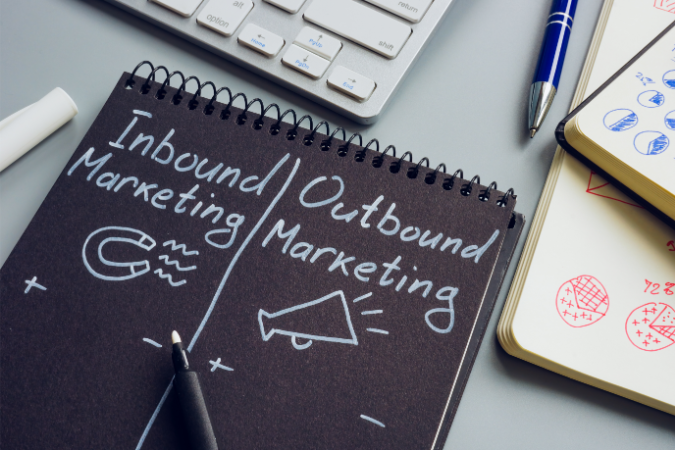Balancing Act: Combining Inbound and Outbound Marketing Strategies Effectively

Inbound marketing vs outbound marketing: To base your opinion on the blogosphere alone, you could say that inbound is now the only way to go, and that outbound is yesterday’s news, but as most businesses will recognise, the picture on the ground is more nuanced. Many outbound marketing strategies are still extremely effective at acquiring leads and customers, and far from replacing outbound, inbound strategies often work alongside outbound methods to increase results from both channels.
So, if outbound marketing strategies work for you and deliver the results you need, there is no need to stop what you are doing. The main argument against outbound marketing and sales is the cost to reward ratio. A lot of outbound methods are costly and resource intensive, so many businesses struggle to get a good ROI. If you can find a way to increase the efficiency of outbound methods so that your overheads are lowered and your returns increased, then everyone’s a winner.
However, this doesn’t mean that you can’t, or shouldn’t, set aside some of your resources and budget for inbound methods. In this article, we’ll explore the fine balancing act of combining inbound and outbound marketing strategies in a way that delivers the optimal results for your business.
Use social media to maximise the value of your events and trade shows
You can use your social media accounts in the run-up to your events to create a buzz, advertise your presence to your network, answer questions, and even set up face-to-face meetings in advance. Tradeshows and business events are a unique opportunity to interact directly with potential customers, and social media simply makes it easier for you to showcase your services, gather leads, and answer questions. A perfect segue between inbound and outbound sales during events is to harvest email addresses that can then be nurtured as part of your email marketing programme, using a marketing automation platform such as HubSpot. During the event itself, you can broadcast live on Facebook, pre-record video interviews to schedule at a later time, and engage with followers not at the event through a live feed on X/Twitter. You can also use your social accounts to follow up with customers and new contacts after the event.
Network with business decision-makers and prospects on LinkedIn
If you love face-to-face networking but haven’t yet invested too much time into LinkedIn, we think that you’ll enjoy what you find there. The platform is like a 24-7 Chamber of Commerce, with hundreds of opportunities for personal contact, networking, group collaboration, serious business discussions, and informal interactions between business decision-makers in your sector. LinkedIn is the perfect complement to face-to-face meetings, too, keeping the conversation going between events, and helping you develop relationships made through outbound marketing.
Invest in high quality content assets
High-quality content is the bedrock of both inbound and outbound marketing. When you approach a prospect through outbound channels, it’s important to have a portfolio of content assets available to help them make an informed sales decision and as the basis for follow-up if you don’t make a sale straight away. As most prospects will want to see your website and/or blog before progressing a deal, a well-organised and regularly updated website will benefit both inbound and outbound strategies. Populate your website and blog with informative articles about key aspects of your service and include a free resources section on your site through which prospects can download (in exchange for an email address) copies of your pricelist, product brochures, technical guides, and other materials to support your outbound sales process.
Consolidate your outbound and inbound communications in a good sales CRM
Keeping everyone on the team organised and singing from the same page is crucial for deploying an efficient outbound marketing strategy. A good ‘inbound’ sales CRM, such as HubSpot CRM, can consolidate your communication from both inbound and outbound approaches within a single contact database, recording all points of contact and enabling you to implement a combined solution to nurture each prospect in whatever way necessary to secure a sale.
Migrate some of your field sales activities to video
No sales are made when sales staff are driving between meetings and stuck in traffic, so it simply makes good commercial sense to migrate some of your field sales activities to video marketing channels. Most decision-makers are now happy to use a video conferencing platform, such as Zoom or MS Teams, for one-to-one conversations or team meetings, and some even prefer it now to phone contact. This not only saves time and money on field sales, but also makes meetings easier to arrange, as it’s quicker to schedule online meetings that don’t require travel time, than it is to get a large team together physically on each side.
Track and measure your outbound marketing efforts using a marketing automation platform
Both inbound and outbound marketing efforts should be closely measured to gauge their effectiveness. Using tools such as Google Analytics and HubSpot to track website traffic and conversions, social media engagement and sales activities will help you identify inefficiencies, maximise success, and make micro adjustments to your approaches as required.
What next?
By integrating your inbound and outbound approaches within a unified digital sales platform, with seamless communication channels between your sales and marketing people, you can attract more customers and increase your results from both strategies. To find out more, please contact one of our experienced team today by clicking here.
Image Source: Canva



